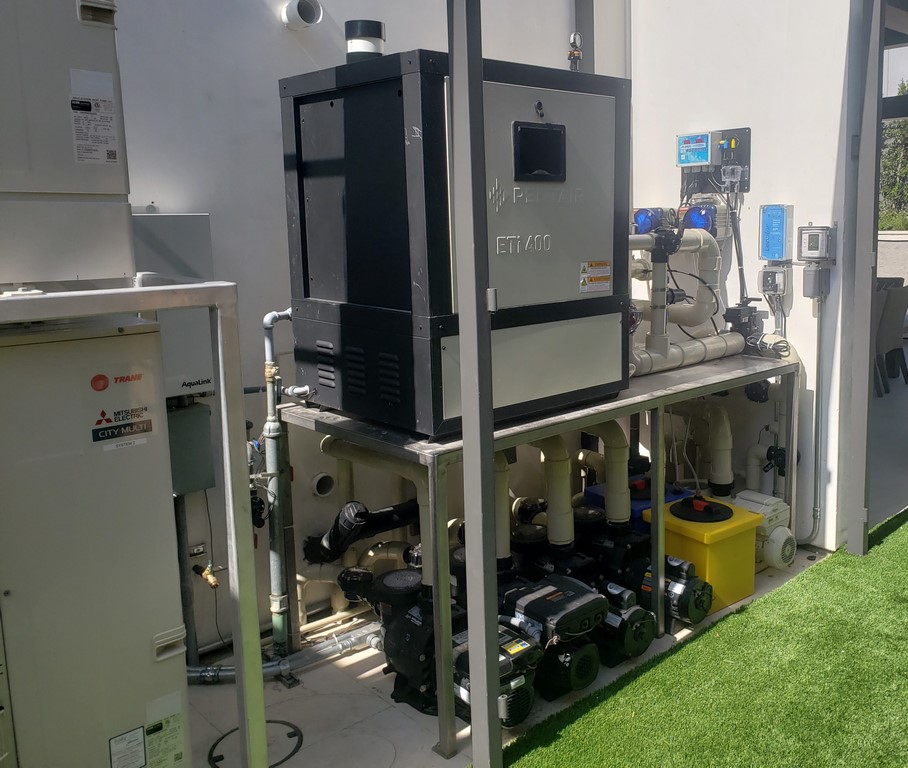Fine Points: Equipment Shelves and Tables


Equipment-pad design often requires making the most of the available space, which in many situations is far too small. Kevin Cobabe faces tight confines in at least half of his projects, he says, which leads to the use of tables and shelves to fit in the needed equipment without compromising efficiency or serviceability.
By Kevin Cobabe
When setting up an equipment pad, space is a luxury. In a perfect world, every project would have ample room for plumbing and equipment, but reality often demands fitting multiple components into a footprint that’s simply too small. In these situations, the best—and often the only—solution is to go vertical.
Equipment pads, rooms, and vaults frequently rely on stacked configurations using shelves and tables to maximize limited space. While reducing the number of components might seem like an option, it can compromise the system’s functionality. I don’t compromise the design simply because the equipment area is smaller than it needs to be.
Instead, a well-planned shelving and table system allows for better access and serviceability while keeping equipment properly organized.
DESIGN & MATERIAL CHOICES
My initial considerations I take into account with every equipment layout is “How will the service guy access all the necessary components for service and repair”—because I could very well be the person that has to repair it, so I want to be sure I have easy clean access to everything making the job easier.
In my experience, at least half of all equipment pads are too small to lay everything out ideally to accommodate manufacturers’ clearances as well as accessibility for future replacement or repair. Depending on the elevation difference between the water level of the vessel and the equipment helps to dictate which components are best suited for tables or shelves.
For example, if equipment is at deck level with the pool, I would not install any pumps on tables or shelves making it more difficult for them to prime and perform at the maximum efficiency. That’s why I often place heaters and filters on tables to free up ground space for pumps. Because pumps require frequent basket cleaning, ensuring accessibility is a priority.
Through trial and error, I’ve refined my approach to table design. Initially, I worked with galvanized tables, but I found they weren’t significantly cheaper than stainless steel and didn’t offer the same durability.
Stainless steel, when properly treated, is virtually bomb-proof and lasts for years. However, if using stainless steel, proper treatment is nonetheless essential. Stainless steel isn’t truly “stainless”—it still oxidizes, just at a slower rate. Welding disrupts the metal’s protective properties, leading to rust formation at the weld joints.
To prevent this, I use a passivating gel on all surfaces with special attention to welded areas, restoring the stainless steel’s corrosion resistance. Neglecting this step can lead to rusting within a year or two, particularly at weld points.
One key improvement I’ve implemented is replacing solid metal tabletops with fiberglass grating. Solid surfaces tend to pool water from rain or maintenance, which can lead to premature rusting and degradation of equipment. Fiberglass grating allows water to drain while also providing flexibility for running pipes or hoses through the table with ease.
ELEVATED INSTALLATION
A well-designed table isn’t just about material—it must also be securely installed. My tables have tabs at the bottom of each leg for bolting them down. It’s also critical to account for the pad’s slope, which often directs water toward a central drain.
If the floor isn’t perfectly level, I adjust table legs by stacking washers under them or having custom leg lengths fabricated. Ensuring the table is level and stable prevents unnecessary vibration and movement, which can impact equipment performance.
Additionally, we have in the past used Unistrut systems to build tables, which allow for quick assembly without a fabricator. These systems can be topped with half-inch PVC sheets or with 1.5-inch fiberglass grating, creating a durable, non-corrosive surface.
For shelves I have developed a design dating back to 1995 based on a shelf designed for a client who had me stack all his pumps on a wall. At the time it was the biggest set of equipment I had installed. It has evolved to a 14-gauge 316 stainless steel shelf needing only two anchor bolts to mount and also has bolt patterns to bolt pumps from the three major manufacturers.
When choosing shelving material, and design, it is important to consider the weight the shelf will need to support. Also, in some shelves in certain shallow vaults can also double as your step ladder to get in and out of said vault, so it’s easy see why they need to be sturdy.
ON THE LEVEL
Maximizing space on an equipment pad often requires creativity and thoughtful design. By utilizing shelving and tables strategically, builders can ensure that all components remain accessible, properly supported, and protected from environmental factors.
Whether using custom-fabricated stainless-steel tables, Unistrut systems, with or without fiberglass grating, the goal is always the same—creating a durable, efficient, and serviceable equipment setup.
Kevin Cobabe is president of Dynamic Pool & Spa Construction, a high-end watershaping firm based in Redondo Beach, CA. He is also a founding member of the International Watershape Institute (IWI), faculty member for Watershape University and a regular contributor to watershapes.com and the Ask the Masters Facebook group. He is also a master “gravy sommelier”.









